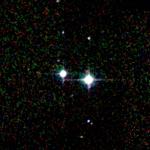Winnecke 4
| Optical double star | |
|---|---|
| Winnecke 4 | |

|
|
| 2MASS image of the double star WNC 4 / M 40 | |
| Constellation | Big Bear |
|
Position equinox : J2000.0 |
|
| Right ascension | 12h 22m 12.53s |
| declination | + 58 ° 04 ′ 58.6 ″ |
| Further data | |
| distance |
(480/1035 LJ ) |
| history | |
| discovery | |
| Date of discovery | |
| Catalog names | |
| M 40, WNC 4 | |
| Aladin previewer | |
Winnecke 4 (short: WNC 4 ) is an optical double star in the Great Bear , consisting of a star of magnitude +9.7 mag and a star of magnitude +10.1 mag. This double star, which can be resolved in a powerful binoculars , was discovered by Charles Messier in 1764 , mistakenly mistaken for a nebula and thus given the designation M40.
The angular distance between the two stars is approx. 50 arc seconds, the less bright one being at a position angle of 83 degrees with respect to the brighter one. The designation Winnecke 4 results from Winnecke's double star measurements .
particularities
Before the measurements of Gaia , all attempts to determine the movement and distance data exactly had failed; the distance was estimated to be 170 ± 70 pc. The gravitational coupling was questionable and therefore unclear whether the object is a real double star. Any period should have lasted at least 232,000 years and the distance would have been at least 5000 AU , which is why the coupling was always considered improbable.
Combined astrometric solutions from the Hipparcos and Gaia satellites give parallaxes that correspond to distance estimates of 350 ± 30 pc and 140 ± 5 pc, respectively. This means that Messier 40 is not a physical double star , but consists of two completely independent stars. With Gaia DR2 , the distance information has once again been made more precise with 317 ± 3 for HD 238107 resp. 146 ± 1 pc for HD 238108 .
See also
Web links
- M40 at SEDS
- Spektrum.de : Amateur recordings [1]
Individual evidence
- ↑ Messier 40. In: SIMBAD . Center de Données astronomiques de Strasbourg , accessed August 19, 2018 .
- ^ Richard L Nugent: The Nature of the Double Star M40 . In: Journal of the Royal Astronomical Society of Canada . 96, 2002, p. 63. bibcode : 2002JRASC..96 ... 63N .
- ↑ Michael R. Merrifield, Meghan E. Gray, Brady Haran: Gaia Shows That Messier 40 is Definitely Not a Binary Star. Retrieved December 7, 2016 .
- ↑ Gaia DR2 1575047353068482688. In: VizieR . Center de Données astronomiques de Strasbourg , accessed August 19, 2018 .
- ↑ Gaia DR2 1575047726729855872. In: Vizier. Center de Données astronomiques de Strasbourg , accessed August 19, 2018 .

